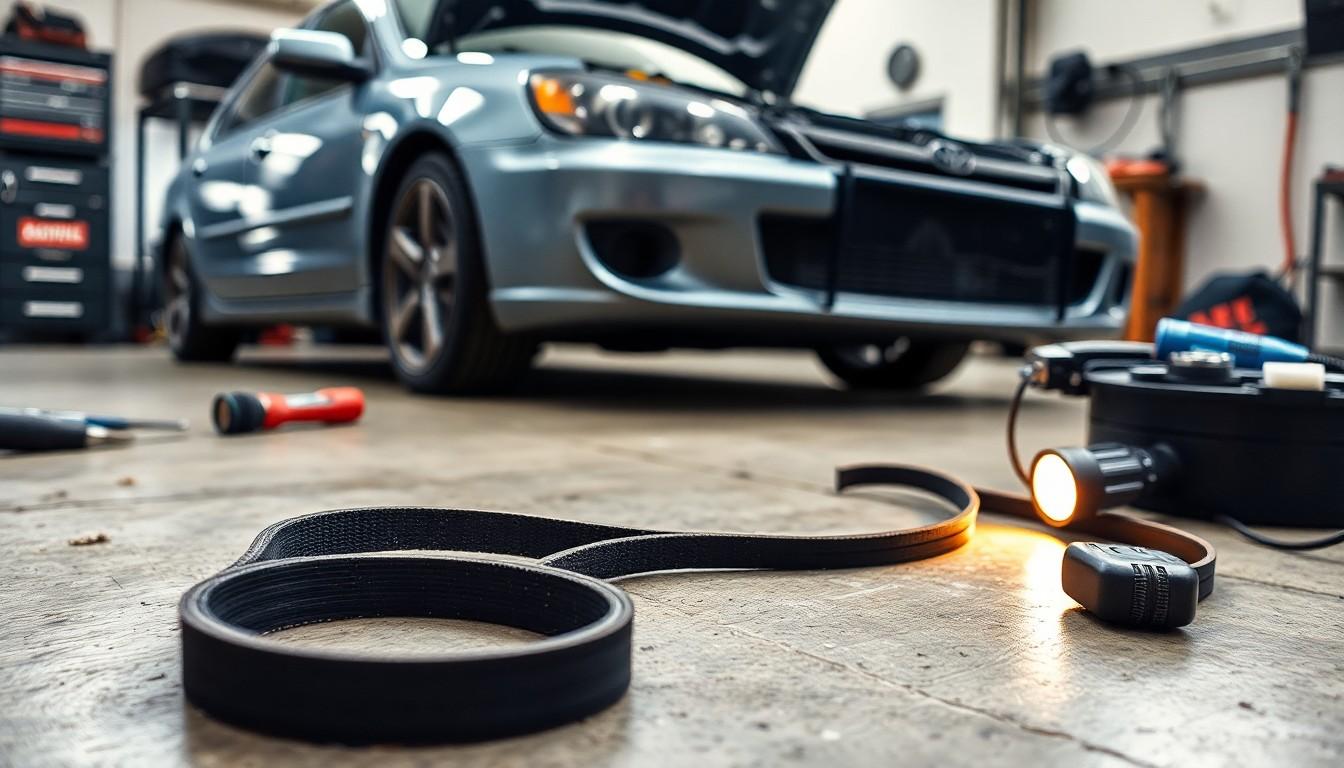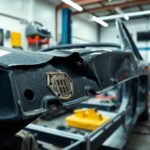A broken serpentine belt can turn your regular commute into a roadside emergency in seconds. This crucial component powers multiple systems in your vehicle, and when it fails, the consequences are immediate and potentially severe. We’ve seen countless drivers stranded after ignoring the warning signs of a deteriorating belt.
We’ll explore exactly what happens when your serpentine belt snaps, from lost power steering making your car difficult to control, to an overheating engine that can lead to expensive damage. Understanding these consequences can save you from being stuck on the side of the road and protect you from costly repairs that could have been prevented with simple maintenance. Let’s jump into why this small part plays such a massive role in your vehicle’s operation.
Understanding the Serpentine Belt in Your Vehicle
The serpentine belt serves as a critical component in modern vehicle engines, transferring power from the crankshaft to multiple peripheral devices. Located at the front of the engine, this single, continuous belt winds around various pulleys to drive essential systems like the alternator, power steering pump, air conditioning compressor, and water pump. Unlike older vehicles that used multiple belts, today’s cars typically employ one serpentine belt to operate all these accessories simultaneously.
Made from durable rubber reinforced with fiber cords, serpentine belts feature a ribbed design on one side that grips the pulleys securely. These belts typically last between 60,000 to 100,000 miles depending on your vehicle make, model, and driving conditions. Environmental factors such as extreme temperatures, oil contamination, and general wear and tear gradually affect the belt’s integrity over time.
A tensioner pulley maintains optimal belt tension, ensuring proper contact with all components. This automatic tensioning mechanism compensates for belt stretching and keeps appropriate pressure throughout the system. Without correct tension, the belt may slip, causing inconsistent operation of essential vehicle systems and accelerating wear on both the belt and connected components.
Regular inspection of your serpentine belt reveals early warning signs of potential failure. Visible cracks, fraying edges, glazing, missing ribs, or unusual squealing noises indicate deterioration requiring immediate attention. Preventive maintenance, including periodic belt inspections, helps avoid the severe consequences of belt failure discussed in subsequent sections of this article.
Signs of a Failing Serpentine Belt

A failing serpentine belt displays several recognizable warning signs before it completely breaks. Identifying these indicators early can help you avoid being stranded with a disabled vehicle and prevent more expensive damage to your engine.
Visual Indicators
Visual inspection reveals the most obvious signs of serpentine belt wear. Cracks, fraying, and splitting along the belt’s surface indicate progressive deterioration that requires immediate attention. Glazing—where the working edge becomes shiny from age and wear—signals the belt is hardening and losing flexibility. Pieces of rubber missing from the belt’s edges or visible wear patterns across the ribs demonstrate advanced degradation. Regular under-hood checks during routine maintenance allow you to spot these visual cues before catastrophic failure occurs.
Unusual Sounds
Distinctive noises often accompany a failing serpentine belt long before it breaks completely. Squealing or chirping sounds, especially during acceleration, indicate the belt is slipping or misaligned on its pulleys. A persistent whining noise points to improper tension, while a flapping sound suggests the belt has become loose or damaged. These audible warnings typically intensify during cold starts or when making sharp turns. A burning rubber smell accompanying these sounds indicates friction is generating excessive heat, further accelerating belt deterioration. Steam or vapor emanating from the engine area serves as another critical warning sign that the serpentine belt system is failing and requires immediate professional attention.
What Happens When a Serpentine Belt Breaks While Driving

When a serpentine belt snaps while you’re on the road, multiple critical vehicle systems fail simultaneously, creating a dangerous driving situation. The effects are immediate and severe, affecting your ability to control the vehicle and potentially leading to serious engine damage.
Loss of Power Steering
Power steering functionality ceases immediately when the serpentine belt breaks. Without the belt driving the power steering pump, turning the steering wheel becomes significantly more difficult, requiring much more physical strength. This sudden change in steering response creates a serious safety hazard, especially when handling curves or attempting emergency maneuvers in traffic.
Overheating Engine
Engine temperature rises rapidly after a serpentine belt failure. The water pump, which circulates coolant throughout the engine, stops functioning when it loses its drive from the belt. Without proper coolant circulation, engine temperatures climb dangerously high within minutes, potentially causing severe and expensive damage to internal engine components.
Battery Depletion
Electrical systems begin failing shortly after the belt breaks. The alternator, responsible for recharging your car’s battery and powering electrical components while the engine runs, depends entirely on the serpentine belt for operation. Once the belt snaps, your vehicle runs solely on battery power, which depletes quickly. Dashboard lights, headlights, and essential electrical systems will gradually dim and eventually fail completely.
Air Conditioning Failure
Cabin comfort deteriorates immediately following a serpentine belt break. The air conditioning compressor relies on the serpentine belt to function, so when the belt fails, cold air stops flowing through the vents. This loss of climate control might seem minor compared to other failures but serves as an early indication that something is seriously wrong with your vehicle’s belt system.
Potential Damage to Other Engine Components

A broken serpentine belt causes cascading damage throughout your engine system, affecting multiple components simultaneously. Engine overheating represents one of the most severe consequences, occurring when the water pump stops functioning due to belt failure. This rapid temperature increase can warp cylinder heads, crack engine blocks, and blow head gaskets—all catastrophic and expensive repairs.
Your alternator immediately stops charging the battery when the serpentine belt breaks, leading to electrical system failures. Headlights might dim, dashboard warning lights could activate, and eventually, the vehicle may stall completely as the battery drains.
Power steering assistance fails instantly without the serpentine belt driving the pump. Steering becomes dramatically more difficult, creating dangerous handling conditions, particularly at higher speeds or during emergency maneuvers when precise control is essential.
The air conditioning compressor also relies on the serpentine belt for operation. Without it, your climate control system loses functionality, resulting in no cold air from the vents regardless of temperature settings.
High-tension belt breakage creates additional hazards beyond system failures. The sudden snap of a taut serpentine belt can damage nearby components, including cooling system hoses, wiring harnesses, and even timing covers. Flying belt fragments might strike and damage radiator fins or cooling fans, compounding overheating issues.
Driving with a broken serpentine belt significantly increases the risk of secondary mechanical failures. The sudden loss of power to multiple systems places unusual strain on related components, potentially leading to premature wear or failure of bearings, pulleys, and mounting brackets.
How to Prevent Serpentine Belt Failure

Preventing serpentine belt failure requires proactive maintenance and attention to key warning signs. Regular monitoring can help avoid the catastrophic consequences of a belt breaking while driving.
Regular Inspections
Regular inspections serve as your first line of defense against unexpected serpentine belt failures. Listen for unfamiliar noises from the engine compartment, particularly squealing or screeching sounds when accelerating. Examine the belt visually for signs of fraying, cracking, splitting, or glazing during routine maintenance checks. Pay attention to component failures, such as power steering issues or air conditioner malfunctions, which often indicate belt problems. Monitor your engine temperature gauge, as overheating can signal that the water pump isn’t receiving proper power from the belt. Check your dashboard for warning lights, especially the check engine light, which might illuminate due to belt-related issues.
Replacement Intervals
Following recommended replacement intervals significantly reduces the risk of serpentine belt failure. Consult your vehicle’s manual for the manufacturer’s exact guidelines, as most recommend replacing the serpentine belt every 50,000 to 100,000 miles. Replace the belt immediately if visual inspections reveal any signs of wear or damage, regardless of mileage. Consider the age of your vehicle and driving conditions in your replacement schedule, as extreme temperatures and harsh environments can accelerate belt deterioration. Many mechanics recommend changing the tensioner pulley simultaneously with the belt to ensure optimal performance of the entire system. Keeping maintenance records helps track when your last belt replacement occurred and plan for the next service.
Emergency Steps if Your Serpentine Belt Breaks

Pull Over Safely and Quickly
Safety comes first when your serpentine belt fails. As soon as you notice symptoms like loss of power steering, engine overheating, or unusual noises, pull over to a safe location immediately. Find a spot away from traffic, preferably on level ground, to minimize additional strain on your vehicle’s systems. Continuing to drive with a broken serpentine belt puts both you and your vehicle at important risk of further damage.
Turn Off Your Engine
Shutting down your engine promptly prevents additional damage to critical components. Once safely parked, turn off your ignition to stop the engine from overheating further. The water pump stops circulating coolant when the serpentine belt breaks, allowing temperatures to rise rapidly within minutes. Your engine temperature gauge might already show dangerous levels, indicating potential damage to cylinder heads and other expensive components.
Avoid Attempting to Drive Further
Driving with a broken serpentine belt isn’t recommended under any circumstances. Without this critical component, your vehicle loses power steering assistance, making it difficult to control, especially at higher speeds or during turns. The alternator also stops charging your battery, leading to electrical system failures that could leave you stranded in potentially dangerous locations. These compounding issues create hazardous driving conditions that aren’t worth the risk.
Call for Professional Assistance
Contacting a towing service or roadside assistance is your best option after a serpentine belt failure. Professional towing prevents additional damage that might occur even during a short drive. If you’re enrolled in a roadside assistance program through your insurance or automobile club, use these services rather than attempting a temporary fix. Many providers offer 24-hour emergency service for situations exactly like this.
Arrange for Prompt Repairs
Getting your vehicle to a qualified repair facility should be your immediate priority. Serpentine belt replacement is typically a straightforward repair, but the associated damage from driving with a broken belt can be extensive and expensive. Qualified mechanics can assess not only the belt but also check for damage to related components like tensioner pulleys, water pumps, and other accessories driven by the belt. Complete repairs prevent recurring issues and ensure your vehicle returns to safe operating condition.
Conclusion
A broken serpentine belt creates a cascade of immediate problems that can leave you stranded and facing expensive repairs. The sudden loss of power steering control battery charging and engine cooling makes this seemingly small component critically important to your vehicle’s operation.
We’ve seen how proper maintenance and regular inspections can help you avoid these dangerous roadside emergencies. By knowing the warning signs and following recommended replacement schedules you’ll extend your vehicle’s life and protect yourself from unexpected breakdowns.
Remember that prevention is always less expensive than repairs. Don’t wait until you’re stuck on the roadside with multiple system failures – include serpentine belt checks in your regular maintenance routine and replace this vital component before it fails.
Frequently Asked Questions
What is a serpentine belt and why is it important?
A serpentine belt is a critical engine component that transfers power from the crankshaft to various accessories including the alternator, power steering pump, air conditioning compressor, and water pump. It’s essential because without it, these systems won’t function properly. When the belt fails, you can lose power steering, your engine can overheat, and your vehicle’s electrical systems may fail, potentially leaving you stranded and facing expensive repairs.
How long does a serpentine belt typically last?
Serpentine belts typically last between 60,000 to 100,000 miles, depending on driving conditions, climate, and belt quality. However, modern belts made from EPDM (Ethylene Propylene Diene Monomer) rubber can sometimes last longer than those made from traditional materials. Regular inspections are still recommended, as premature wear can occur due to environmental factors or mechanical issues.
What are the warning signs of a failing serpentine belt?
Warning signs include visible cracks, fraying, or glazing on the belt; unusual noises like squealing, whining, or flapping; a burning rubber smell; and steam coming from the engine area. You might also notice dashboard warning lights, difficulty steering, dimming headlights, or engine overheating. Regular under-hood checks can help catch these problems before a complete failure occurs.
What happens if my serpentine belt breaks while driving?
If your serpentine belt breaks while driving, multiple critical systems fail simultaneously. You’ll lose power steering, making the vehicle difficult to control. The engine will begin overheating rapidly as the water pump stops working. The alternator will stop charging the battery, causing electrical systems to fail. These combined failures create a dangerous driving situation and can lead to extensive engine damage.
Can a broken serpentine belt cause engine damage?
Yes, a broken serpentine belt can cause serious engine damage. Without the belt, the water pump stops circulating coolant, leading to rapid overheating. This can warp cylinder heads, crack the engine block, or blow head gaskets—all extremely expensive repairs. Additionally, the sudden strain on related components can cause secondary mechanical failures, compounding the damage and repair costs.
How can I prevent serpentine belt failure?
Prevent serpentine belt failure by following these steps: schedule regular inspections every 6 months or during oil changes; listen for unusual noises; visually check for cracks, fraying, or glazing; follow manufacturer-recommended replacement intervals (typically 50,000-100,000 miles); replace the tensioner pulley when changing the belt; and keep maintenance records. Being proactive about belt maintenance can save you from costly repairs and roadside emergencies.
What should I do if my serpentine belt fails while driving?
If your serpentine belt fails while driving, immediately pull over to a safe location and turn off your engine to prevent further damage. Don’t attempt to drive the vehicle as this can cause catastrophic engine damage. Call for roadside assistance or a tow service to transport your vehicle to a repair facility. Have a qualified mechanic inspect related components for additional damage before replacing the belt.
Is it difficult to replace a serpentine belt?
Replacing a serpentine belt ranges from moderately difficult to complex, depending on your vehicle model. While the actual replacement isn’t complicated, accessing the belt and properly routing it around all pulleys can be challenging without specialized tools. Most vehicles require a tensioner tool to release the tension. For many drivers, professional replacement is recommended to ensure proper installation and tension.
How much does it cost to replace a serpentine belt?
Serpentine belt replacement typically costs between $75 and $200, including parts and labor. The belt itself usually costs $25-$75, while labor makes up the remainder. Costs vary based on vehicle make and model, as some engines require more labor time for access. This preventive maintenance is significantly less expensive than repairing the damage caused by a broken belt.
Should I replace my tensioner pulley with the serpentine belt?
Yes, it’s highly recommended to replace the tensioner pulley when installing a new serpentine belt. The tensioner maintains proper belt tension and often wears out at a similar rate to the belt. A worn tensioner can cause premature failure of your new belt and lead to the same problems you were trying to avoid. The small additional cost provides significant protection against future failures.







